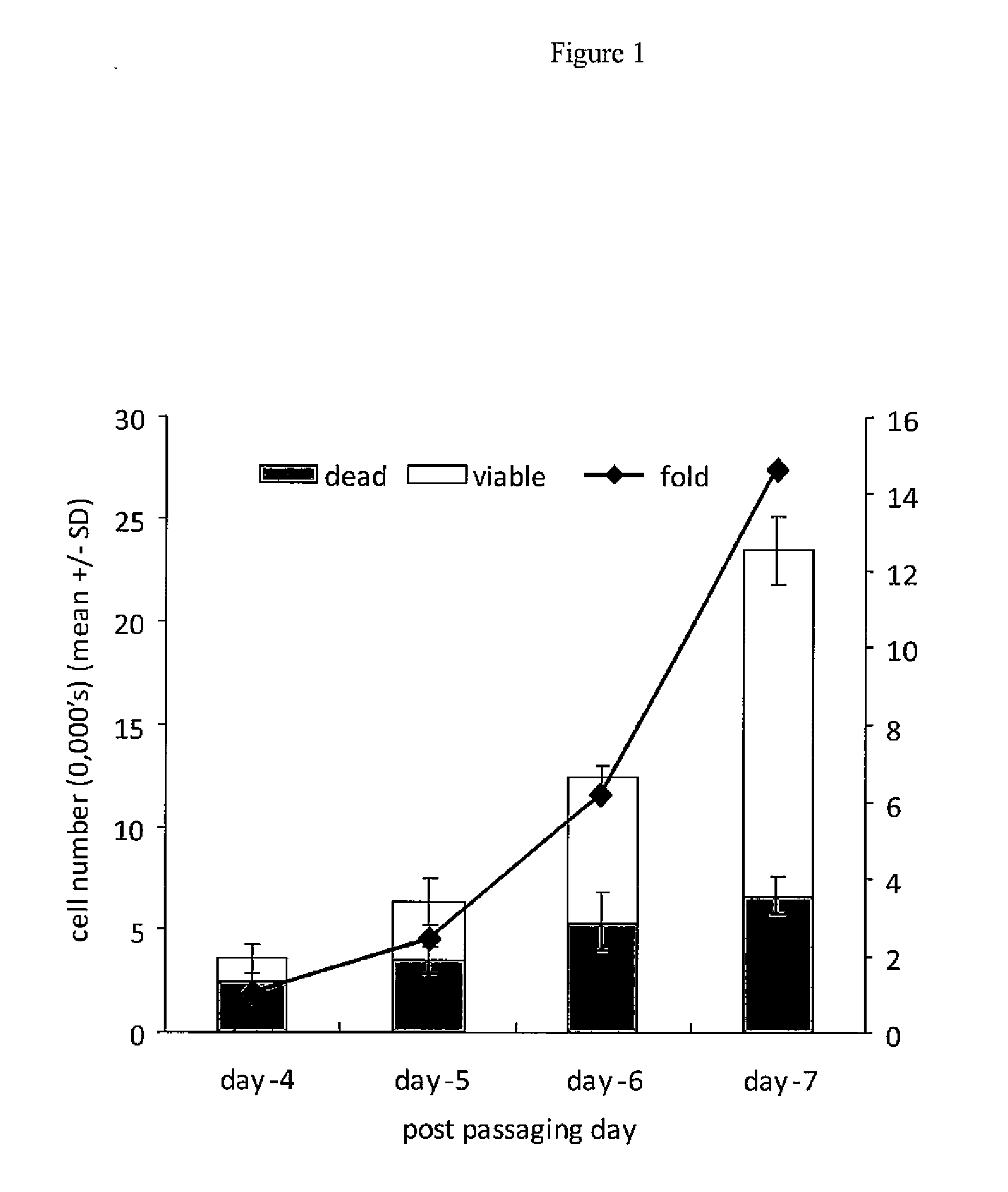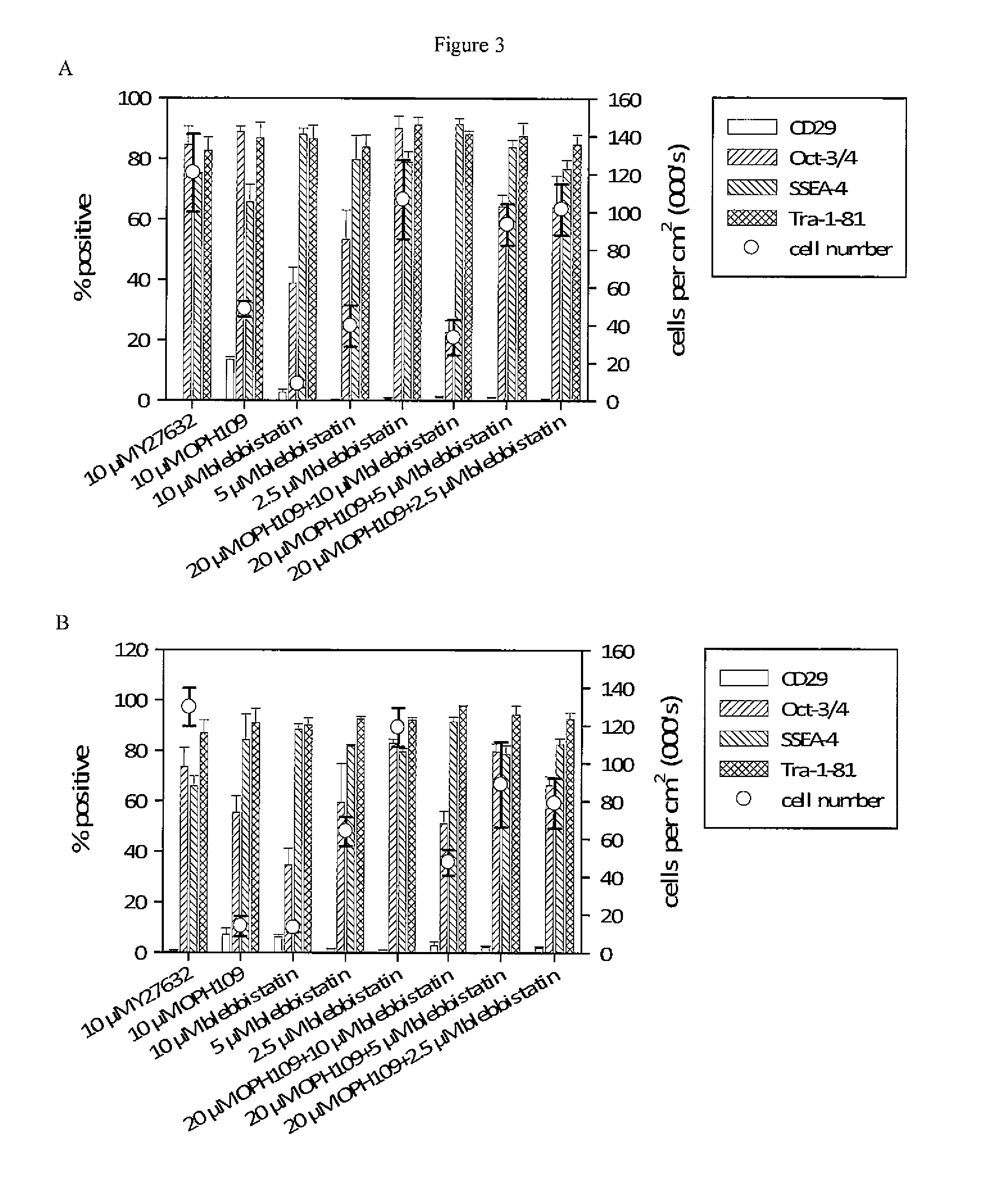Media and methods for cell culture
a cell culture and media technology, applied in the field of media and cell culture, can solve the problems of inconvenient culturing, inconvenient culturing, and difficulty in adapting processes, and achieve the effects of uniform passaging, small volume culture, and inconsistent cell distribution
- Summary
- Abstract
- Description
- Claims
- Application Information
AI Technical Summary
Benefits of technology
Problems solved by technology
Method used
Image
Examples
example 1
Passaging of hESC Using Gelatin / EGTA
[0082]hESC used for these experiments were derived as described previously (Peura et al., 2008). In brief, blastocyst stage embryos were plated onto gelatin-coated tissue culture dishes containing mitomycin C-inactivated human foetal fibroblasts (hereafter referred to as feeder cells; ATCC) in KO-DMEM with 20% Knockout Serum Replacement (KSR), 2 mM glutamine, 50 U / ml penicillin, 50 mg / ml streptomycin, 1×MEM-amino acids, 0.1 mM β-mercaptoethanol (all Invitrogen), hereafter referred to as KSR medium, and 20 ng / ml bFGF (Sigma). Cells were incubated at 37° C. / 5% C02 / 5% O2, with outgrowths from the inner cell mass expanded by manual passaging and cultured as described above, with the exception that 4 ng / ml bFGF was used in the KSR medium. Outgrowths were karyotyped and confirmed as pluripotent hESC lines by evaluation of pluripotency markers and the ability to form the 3 germ layers in teratoma experiments using SCID mice. The hESC lines used in exampl...
example 2
Characterization of hESC Passaged Using Gelatin / EGTA
[0085]To determine if hESC lines passaged using gelatin / EGTA maintain the hallmark characteristics of stem cells, the karyotype and expression of pluripotency markers after multiple passages was examined.
[0086]hESC were passaged using gelatin / EGTA as described in Example 1. Cells were karyotyped as previously described (Peura et al., 2008). For enrichment of cells in M phase, outgrowths were incubated with either 0.22 ng / ml colcemid (KaryoMAX) and 37.5 g / ml BrdU for 17-19 hrs or 5 ng / ml colcemid for 2.5 hrs. Single cells were subsequently obtained using Non-enzymatic Cell Dissociation Solution (Sigma) and metaphase spreads prepared for G-banding. Karyotyping revealed SIVF001 hESC at gelatin / EGTA passage 13, 20 and 33, as well as SIVF019 cells at passage 12, were cytogenetically normal (Table 2).
[0087]SIVF001 hESC passaged 27 times using gelatin / EGTA were assessed for the expression of pluripotency markers by immunohistochemistry. T...
example 3
Testing of Different Water-Soluble Polymers for hESC Passaging
[0088]To determine if other water-soluble polymers are suitable for hESC passaging, hESC were passaged using EGTA combined with either agarose, dextran, PEG, PVP or gelatin.
[0089]Single cells were generated using the same method as described in Example 1, with the exception of different water-soluble polymers used in place of gelatin, being either 0.1% agarose (Sigma #A2576), 0.5% dextran (Sigma #00269), 0.5% PEG (Sigma #P3015) or 0.5% PVP (Sigma #P5288). All water-soluble polymers were dissolved in PBS containing 2 mM EGTA and autoclaved, hESC used in the experiment were SIVF001 cells which had been passaged 30 times using the gelatin / EGTA method, seeded into 6 well plates (FIG. 5A). These cells were then passaged 3 times with a split ratio of 1:10 using different water-soluble polymers / EGTA solutions. Significantly more hESC colonies were observed in the presence of water soluble polymers. After 7 days in culture the ce...
PUM
 Login to View More
Login to View More Abstract
Description
Claims
Application Information
 Login to View More
Login to View More - R&D
- Intellectual Property
- Life Sciences
- Materials
- Tech Scout
- Unparalleled Data Quality
- Higher Quality Content
- 60% Fewer Hallucinations
Browse by: Latest US Patents, China's latest patents, Technical Efficacy Thesaurus, Application Domain, Technology Topic, Popular Technical Reports.
© 2025 PatSnap. All rights reserved.Legal|Privacy policy|Modern Slavery Act Transparency Statement|Sitemap|About US| Contact US: help@patsnap.com



